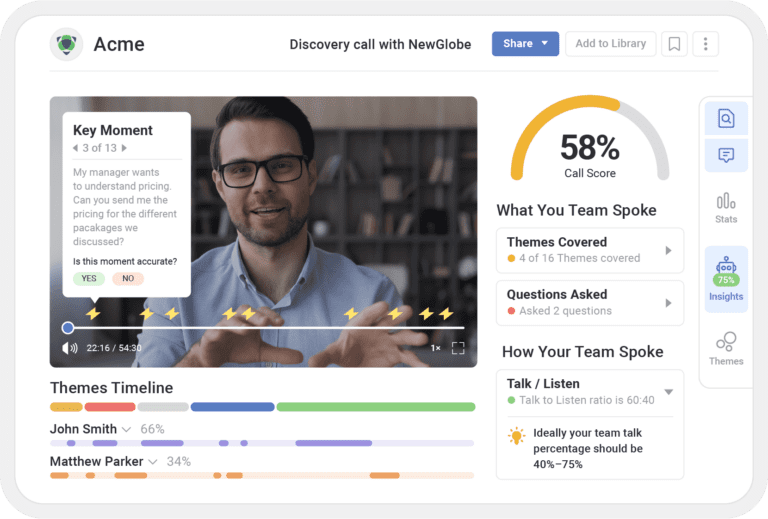When it comes to prospect interactions, quantity certainly matters. If a seller isn’t interacting with prospects, they’re not going to close enough business. But simply increasing the number of meetings and calls isn’t enough to guarantee more deals.
Instead, sellers must also master the skills needed to improve the quality of their interactions. Only then will more of their calls lead to closed deals.
Yet, most sellers are familiar with that sinking feeling that comes after a sales call has gone wrong. Maybe they ran out of time and didn’t have the chance to cover everything they’d hoped to. Perhaps the prospect barely spoke. Or, maybe the buyer raised objections the seller just wasn’t ready to handle — which left them fumbling.
Usually, these calls leave reps (and their managers) wondering what they can do to improve the outcome next time. While no two sales calls are the same, there are commonalities across all great calls. The first step to success is to take a closer look at what the best sales orgs are doing differently on their sales calls. This is exactly what we did.
Recently, we analyzed nearly half a million sales calls recorded in 2023 using Call AI, Mindtickle’s conversation intelligence solution. We also compared this analysis to previous years to understand how things have changed over time. Based on these new insights, we’ve compiled our top six tips for getting the most out of sales calls.
Key takeaways
- More calls doesn’t mean more closed deals. Focus on improving the quality of rep calls to increase their effectiveness.
- Balance participation between reps and customers. Make sure there’s time to ask and answer questions on both sides.
- Make sure your reps aren’t hogging the stage. Train your reps to listen to customer pain points rather than deliver long monologues.
1. Optimize sales call length – and make the most of your time
Have you ever scheduled a 30-minute sales call, only to run out of time before you’ve covered everything you wanted to? Maybe the customer had a lot of questions, or perhaps they took things in a different direction than you anticipated. As the end of your time approached, you likely felt a sense of panic kick in, and you may have come across as rushed or disorganized.
So if you’ve scheduled 30 minutes, you have a few options. You can ask the prospect if it’s possible to run over (which it often isn’t, as prospects have busy schedules, too). Or, you can end the call without covering everything — and hope the prospect agrees to another call. Neither situation is ideal.
In order to avoid this situation, it’s important to optimize the length of your sales calls. But what’s the right amount of time to book on your prospect’s calendar?
Our analysis found that the average length of a sales call recorded, transcribed, and analyzed with Mindtickle in 2023 was 30 minutes, which is down from 36-37 minutes the prior year. However, the average length of a discovery call is 36 minutes.
In 2022, the average sales call was
In 2023, the average sales call was
Take a look at your own sales calls to evaluate length. Use those insights to determine how long you should schedule calls for. When in doubt, schedule more time. For example, rather than scheduling a half hour call, schedule it for 40 minutes. If you don’t need the entire time, you can always give the prospect or customer some time back, which is preferable to going over your time.
In addition, be sure your reps show up ultra-prepared. That way, they can make the most of their time with buyers – no matter how much time that may be.
2. Share the mic – especially on discovery calls
A sales call, like any conversation, should be a give and take. Both parties should have an equal opportunity to share what’s on their mind — and ask and answer questions.
But often, that’s not the case. Instead, sales reps do the lion’s share of the talking — while prospects sit quietly and (hopefully) take it all in. On average, customers talk just 37% of the time on sales calls, which is down significantly from 44% in 2021.
In 2021, customers talked
In 2023, customers talked
Customers speak up a bit more during discovery calls. During discovery stages, they speak 43% of the time, which is down from 41% in 2021.
If you’re looking to get more out of your sales calls, coach your sellers to give prospects plenty of airtime on calls — especially in the discovery stages. If your team is struggling to get the prospect to talk more, this may be an opportunity to look at the discovery questions asked. Are they thought-provoking? Do they warrant more than a one-word answer? Curating a list of deep-dive discovery questions will get your prospects sharing more, so you can better prepare for the next conversation.
3. Keep monologues in check
Have you ever been in a situation where someone’s telling you a long, drawn-out story? Your eyes might glaze over, while your attention drifts to other things.
The same can happen on sales calls with the rep delivering a long, droning response to a prospect’s questions. As a general rule, the longer the monologue, the more disengaged a prospect gets.
We found that, on average, the longest monologue response delivered by reps in 2023 2 was minutes and 15 seconds. In comparison, the average longest monologue delivered by reps in 2022 was 2 minutes and 43 seconds.
In 2022, the longest rep monologue was
In 2023, the longest rep monologue was
Though monologues are decreasing in length, it’s critical for reps to be mindful. If a seller finds themself speaking for more than a minute and a half, it’s important to check in and see if the prospect has any questions. Doing so helps ensure a balance of rep and prospect participation and engagement.
4. Equip sellers to handle objections
Ideally, every sales call will end on a positive note. The prospect will feel excited about the seller’s solution — and eager to move on to the next step of the sales process.
But that’s not reality.
Negative sentiment, such as uncertainty, hesitancy, competitive mentions, and objections, are extremely common on sales calls. In fact, over half (54%, to be exact) of sales calls contain more negative sentiment than positive.
In 2023
But negative sentiment doesn’t mean the call is a lost cause — especially if the seller has been adequately trained and coached to expect resistance and overcome it. When a prospect brings up competitors and challenges statements made during the call, it often means they have done their research, indicating that they have prioritized the search for a solution like yours.
Of course, it’s important to provide enablement that ensures reps know your messaging inside and out and can properly differentiate you from your competitors. Be sure you’re also spending time on enablement topics that help reps build their confidence and overcome common objections.
5. Ask and invite questions
When a rep asks questions, it shows they’re clarifying deal information and deepening their discovery. On average, reps ask 20 questions during sales discovery, which is down from 25 questions the prior year.
In 2022, reps asked
In 2023, reps asked
On the other hand, when a rep receives a question from a prospect, it can be indicative of the potential customer’s needs and priorities. On average, sellers receive 12 questions from prospects during sales discovery. Of course, this will vary based on factors including prospect preparedness, confidence levels, decision-making stage, and time constraints. In 2022, the average number of questions a seller received during a discovery call was 18.
During the best sales calls, questions are asked by both parties. Yet, we’re seeing a decline in questions posed by both buyers and sellers.
Be sure to provide your reps with the coaching and resources they need to improve their questioning techniques. Boosting these skills can help foster more engaging and insightful customer interactions. y In addition, be sure to review your top discovery calls. That way, you can create a list of the questions that best uncover additional deal information and get the prospect thinking.
6. Leverage conversation intelligence software
Let’s be real: sales calls don’t always go well. And when they go south, reps often struggle to articulate what exactly went wrong. That makes it difficult (or even impossible) for the sales manager to provide coaching that’ll improve future outcomes.
Furthermore, front-line managers are busy and don’t have the bandwidth to sit in on every single call for every single rep. That’s why the best sales orgs use conversation intelligence software to bridge the gap.
Conversation intelligence software records sales calls and leverages AI to help managers identify where reps are excelling — and where there are skill gaps. Managers can use these insights to deliver personalized enablement, content, and coaching to close those gaps, improve key skills, and boost sales outcomes.

With all of your calls recorded, reps can better prepare for meetings. Conversation intelligence products like Call AI send digest emails with summaries and key action items from the last call with a prospect. In addition to call prep, sellers can collaborate and coach each other on key selling moments, soliciting feedback and viewing top call moments from their team members.
Ready to get more out of your sales calls?
Want to learn more about what winning revenue organizations are doing to ensure each member of the team is always ready to close deals?
Get a DemoThis post was originally published in June 2022 and was updated in April 2024.







